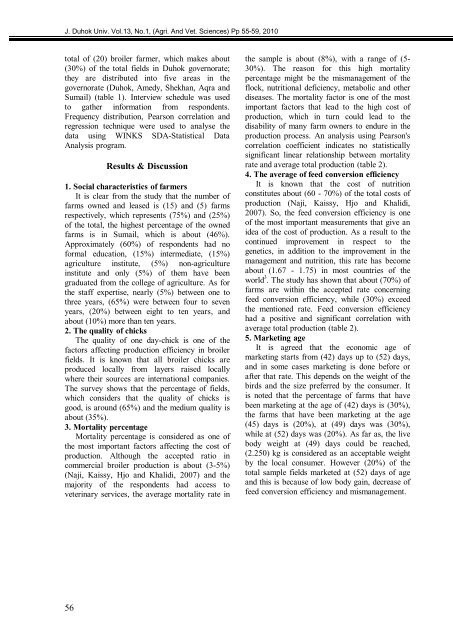The Influence Of Priming Two Cucumber Cultivar Seeds
The Influence Of Priming Two Cucumber Cultivar Seeds
The Influence Of Priming Two Cucumber Cultivar Seeds
Create successful ePaper yourself
Turn your PDF publications into a flip-book with our unique Google optimized e-Paper software.
J. Duhok Univ. Vol.13, No.1, (Agri. And Vet. Sciences) Pp 55-59, 2010<br />
total of (20) broiler farmer, which makes about<br />
(30%) of the total fields in Duhok governorate;<br />
they are distributed into five areas in the<br />
governorate (Duhok, Amedy, Shekhan, Aqra and<br />
Sumail) (table 1). Interview schedule was used<br />
to gather information from respondents.<br />
Frequency distribution, Pearson correlation and<br />
regression technique were used to analyse the<br />
data using WINKS SDA-Statistical Data<br />
Analysis program.<br />
55<br />
Results & Discussion<br />
1. Social characteristics of farmers<br />
It is clear from the study that the number of<br />
farms owned and leased is (15) and (5) farms<br />
respectively, which represents (75%) and (25%)<br />
of the total, the highest percentage of the owned<br />
farms is in Sumail, which is about (46%).<br />
Approximately (60%) of respondents had no<br />
formal education, (15%) intermediate, (15%)<br />
agriculture institute, (5%) non-agriculture<br />
institute and only (5%) of them have been<br />
graduated from the college of agriculture. As for<br />
the staff expertise, nearly (5%) between one to<br />
three years, (65%) were between four to seven<br />
years, (20%) between eight to ten years, and<br />
about (10%) more than ten years.<br />
2. <strong>The</strong> quality of chicks<br />
<strong>The</strong> quality of one day-chick is one of the<br />
factors affecting production efficiency in broiler<br />
fields. It is known that all broiler chicks are<br />
produced locally from layers raised locally<br />
where their sources are international companies.<br />
<strong>The</strong> survey shows that the percentage of fields,<br />
which considers that the quality of chicks is<br />
good, is around (65%) and the medium quality is<br />
about (35%).<br />
3. Mortality percentage<br />
Mortality percentage is considered as one of<br />
the most important factors affecting the cost of<br />
production. Although the accepted ratio in<br />
commercial broiler production is about (3-5%)<br />
(Naji, Kaissy, Hjo and Khalidi, 2007) and the<br />
majority of the respondents had access to<br />
veterinary services, the average mortality rate in<br />
the sample is about (8%), with a range of (5-<br />
30%). <strong>The</strong> reason for this high mortality<br />
percentage might be the mismanagement of the<br />
flock, nutritional deficiency, metabolic and other<br />
diseases. <strong>The</strong> mortality factor is one of the most<br />
important factors that lead to the high cost of<br />
production, which in turn could lead to the<br />
disability of many farm owners to endure in the<br />
production process. An analysis using Pearson's<br />
correlation coefficient indicates no statistically<br />
significant linear relationship between mortality<br />
rate and average total production (table 2).<br />
4. <strong>The</strong> average of feed conversion efficiency<br />
It is known that the cost of nutrition<br />
constitutes about (60 - 70%) of the total costs of<br />
production (Naji, Kaissy, Hjo and Khalidi,<br />
2007). So, the feed conversion efficiency is one<br />
of the most important measurements that give an<br />
idea of the cost of production. As a result to the<br />
continued improvement in respect to the<br />
genetics, in addition to the improvement in the<br />
management and nutrition, this rate has become<br />
about (1.67 - 1.75) in most countries of the<br />
world 3 . <strong>The</strong> study has shown that about (70%) of<br />
farms are within the accepted rate concerning<br />
feed conversion efficiency, while (30%) exceed<br />
the mentioned rate. Feed conversion efficiency<br />
had a positive and significant correlation with<br />
average total production (table 2).<br />
5. Marketing age<br />
It is agreed that the economic age of<br />
marketing starts from (42) days up to (52) days,<br />
and in some cases marketing is done before or<br />
after that rate. This depends on the weight of the<br />
birds and the size preferred by the consumer. It<br />
is noted that the percentage of farms that have<br />
been marketing at the age of (42) days is (30%),<br />
the farms that have been marketing at the age<br />
(45) days is (20%), at (49) days was (30%),<br />
while at (52) days was (20%). As far as, the live<br />
body weight at (49) days could be reached,<br />
(2.250) kg is considered as an acceptable weight<br />
by the local consumer. However (20%) of the<br />
total sample fields marketed at (52) days of age<br />
and this is because of low body gain, decrease of<br />
feed conversion efficiency and mismanagement.



